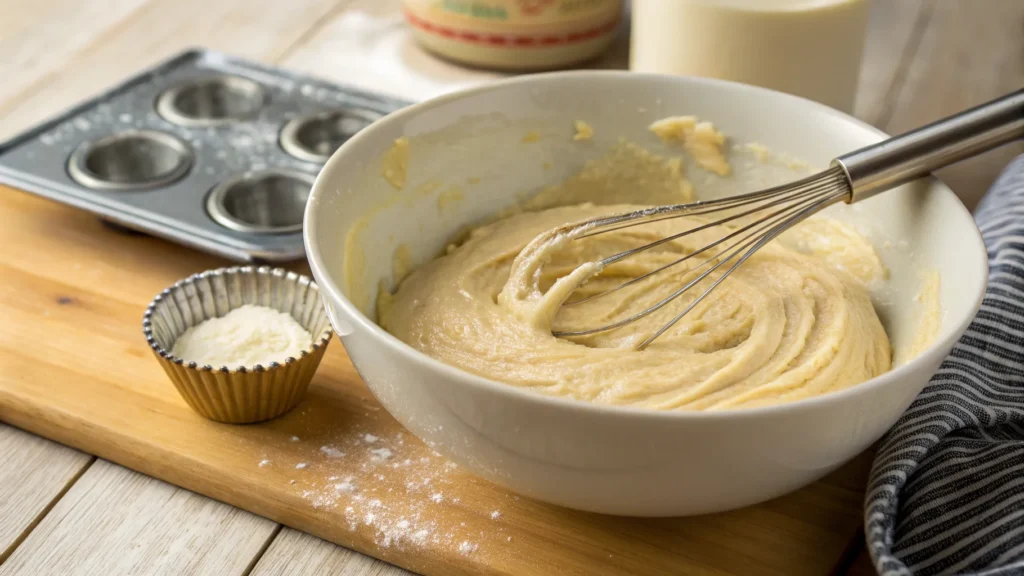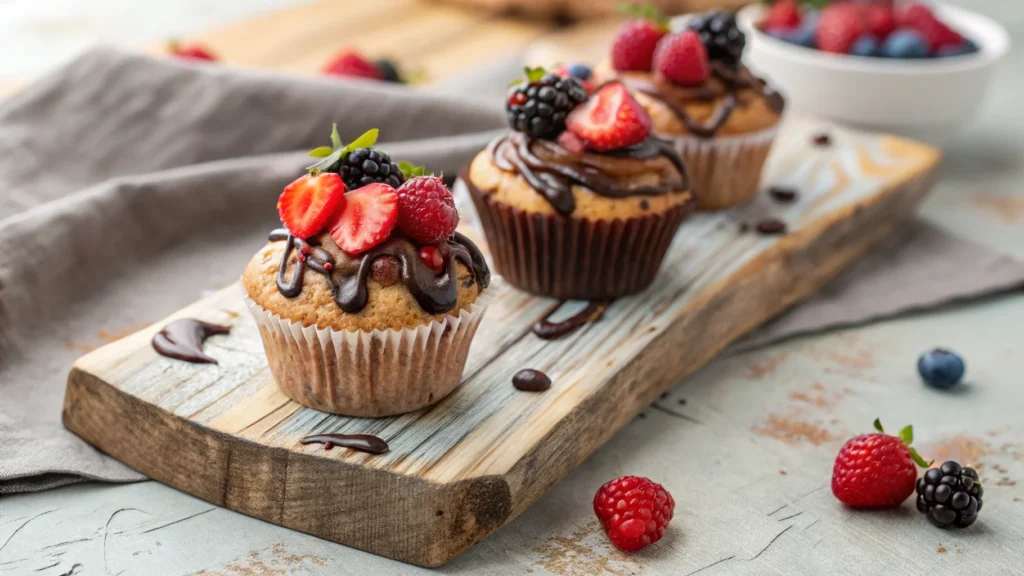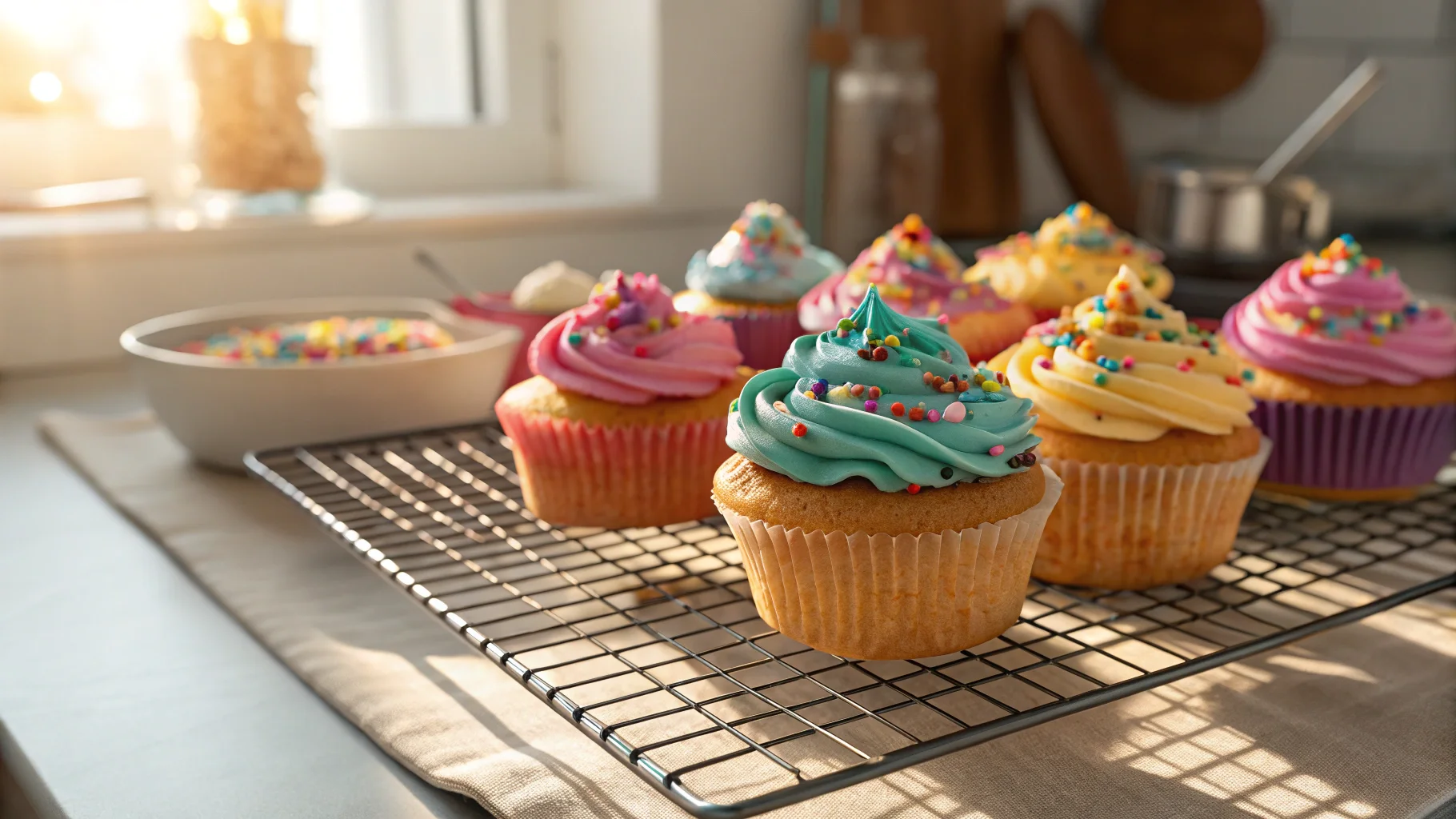Gluten-free cupcakes are the perfect solution for anyone craving a delicious dessert without the gluten. Whether you’re baking for dietary restrictions or simply looking to explore new recipes, these cupcakes are an ideal option. In this guide, we’ll delve into everything you need to know about gluten-free cupcakes—from essential ingredients and baking tips to troubleshooting common issues. Let’s get started on crafting cupcakes that everyone can enjoy, regardless of dietary needs!
Explore more about our simple and versatile dessert recipes here.
Understanding Gluten-Free Cupcakes
What Are Gluten-Free Cupcakes?
Gluten-free cupcakes are made without gluten, a protein found in wheat, barley, and rye. These cupcakes rely on alternative flours and ingredients to create a texture and flavor similar to traditional cupcakes. They’re an excellent choice for those with celiac disease or gluten sensitivity, ensuring everyone can indulge in a sweet treat without worry.
Why Choose Gluten-Free Cupcakes?
There are several reasons to opt for gluten-free cupcakes:
- Dietary Needs: Gluten-free cupcakes are essential for those with gluten intolerances or celiac disease.
- Healthier Alternatives: Gluten-free recipes often include nutrient-rich flours like almond, coconut, or rice flour, which can be healthier than refined wheat flour.
- Inclusivity: These cupcakes ensure that everyone at your gathering has a dessert option, regardless of dietary restrictions.
The Growing Popularity of Gluten-Free Baking
In recent years, gluten-free baking has become a culinary trend, not just for health reasons but also for creativity in the kitchen. The rise in gluten-free products and recipes has made it easier than ever to bake delicious cupcakes that rival their traditional counterparts. With a little know-how and the right ingredients, gluten-free cupcakes can be just as moist, fluffy, and tasty as regular ones.
Ingredients for Perfect Gluten-Free Cupcakes
Essential Ingredients for Gluten-Free Baking
Creating gluten-free cupcakes starts with the right ingredients. The absence of gluten means you need substitutes to achieve the same structure, flavor, and texture as traditional cupcakes. Here’s what you’ll need:
- Gluten-Free Flour Blends: These are pre-mixed combinations of flours, starches, and xanthan gum, designed for baking success. Popular brands include Bob’s Red Mill and King Arthur Baking.
- Xanthan Gum or Guar Gum: These ingredients act as binders, replacing the elasticity of gluten and ensuring the batter holds together.
- Leavening Agents: Baking powder and baking soda are crucial for achieving a fluffy texture.
- Liquid Ingredients: Milk (or non-dairy alternatives), eggs, and oil add moisture and richness.
Which Flour Is Best for Gluten-Free Cupcakes?
The type of flour you use can significantly impact your cupcakes. Here are some top choices:
- Almond Flour: Adds a rich, nutty flavor and moist texture.
- Coconut Flour: A low-carb option, but it absorbs a lot of liquid, so adjust recipes accordingly.
- Rice Flour: Common in gluten-free blends, it provides a neutral taste and light texture.
- Sorghum Flour: Offers a mild, sweet flavor, great for balancing other ingredients.
Other Substitutes for Traditional Gluten Ingredients
- Starches: Tapioca, cornstarch, or arrowroot powder enhance the structure and softness of cupcakes.
- Sweeteners: Use granulated sugar, honey, or maple syrup, depending on the recipe.
- Dairy Alternatives: Almond milk, coconut milk, or oat milk work well for lactose-free and gluten-free options.
Pro Tip for Ingredient Selection
Always check labels to ensure all ingredients are certified gluten-free. Even trace amounts of gluten in products like vanilla extract or baking powder can affect those with severe sensitivities.
Step-by-Step Recipe for Gluten-Free Cupcakes
Preparing the Ingredients
Before starting, ensure all your ingredients are at room temperature for smoother mixing and better consistency. Here’s what you’ll need for a basic gluten-free cupcake recipe:
- Dry Ingredients:
- 1 ½ cups gluten-free all-purpose flour
- 1 tsp xanthan gum (if not included in the flour blend)
- 1 tsp baking powder
- ½ tsp baking soda
- ¼ tsp salt
- Wet Ingredients:
- 2 large eggs
- ½ cup granulated sugar
- ½ cup vegetable oil or melted butter
- 1 tsp pure vanilla extract
- ½ cup milk or non-dairy alternative
Mixing the Batter for a Perfect Consistency

- Combine the Dry Ingredients: In a large bowl, whisk together the gluten-free flour, xanthan gum, baking powder, baking soda, and salt. This ensures the leavening agents are evenly distributed.
- Prepare the Wet Ingredients: In another bowl, beat the eggs and sugar until light and fluffy. Gradually add the oil and vanilla extract, mixing until smooth.
- Incorporate the Milk: Slowly pour in the milk, alternating with the dry ingredients. Begin and end with the dry ingredients for a lump-free batter.
- Avoid Overmixing: Gently fold the batter until just combined. Overmixing can lead to dense cupcakes.
Baking Tips for Fluffy Gluten-Free Cupcakes
- Preheat and Prepare: Preheat your oven to 350°F (175°C). Line a muffin tin with cupcake liners for easy cleanup.
- Fill the Cups: Use a cookie scoop to fill each liner about 2/3 full to allow room for rising.
- Bake to Perfection: Place the tin in the oven and bake for 18-20 minutes or until a toothpick inserted in the center comes out clean.
- Cool Completely: Allow the cupcakes to cool in the tin for 5 minutes before transferring them to a wire rack to cool completely.
Check out our guide to making fresh apple cake, another delicious gluten-free option.
Optional Flavor Variations
- Chocolate: Add 2 tbsp of cocoa powder to the dry ingredients for a rich, chocolatey twist.
- Lemon: Mix in 1 tsp of lemon zest and 1 tbsp of lemon juice for a zesty flavor.
- Vanilla Bean: Swap vanilla extract for vanilla bean paste for a more robust flavor.
Common Challenges in Gluten-Free Cupcake Baking
Why Do Gluten-Free Cupcakes Sink in the Middle?
One of the most common issues bakers face is sinking cupcakes. Here’s why it happens and how to fix it:
- Overmixing the Batter: Overmixing incorporates too much air, causing the cupcakes to rise rapidly and then collapse as they cool.
- Solution: Mix the batter gently and stop as soon as the ingredients are combined.
- Incorrect Oven Temperature: An oven that’s too hot can cause the cupcakes to rise too quickly and then sink.
- Solution: Use an oven thermometer to ensure accurate temperatures.
- Not Enough Structure: Without gluten, the batter needs binders like xanthan gum to hold its shape.
- Solution: Always use a gluten-free flour blend with xanthan gum or add it separately.
How to Avoid Dry or Crumbly Cupcakes
Dry cupcakes can be disappointing, but this is preventable with a few adjustments:
- Insufficient Moisture: Gluten-free flours often absorb more liquid.
- Solution: Add an extra tablespoon of milk or use oil instead of butter for added moisture.
- Overbaking: Even a few extra minutes in the oven can dry out gluten-free cupcakes.
- Solution: Check for doneness early using the toothpick test. Remove from the oven as soon as it comes out clean.
- Improper Storage: Storing cupcakes without proper wrapping can dry them out.
- Solution: Store them in an airtight container or wrap individually with plastic wrap.
Mistakes to Avoid for Consistently Great Results
- Skipping the Resting Period: Let the batter rest for 5-10 minutes before baking. This helps hydrate the flour and improves texture.
- Using Incorrect Flour Blends: Not all gluten-free flours are interchangeable. Choose a blend specifically designed for baking.
- Ignoring Recipe Ratios: Precise measurements are crucial in gluten-free baking. Too much flour or liquid can throw off the entire recipe.
Gluten-Free Cupcakes vs. Regular Cupcakes
What’s the Difference in Taste?
The taste of gluten-free cupcakes often surprises first-timers with its similarity to regular cupcakes. However, there are subtle differences:
- Gluten-Free Cupcakes: They tend to have a slightly nuttier or earthier flavor due to alternative flours like almond, coconut, or rice flour.
- Regular Cupcakes: Traditional cupcakes have a neutral, wheat-flour base that acts as a blank canvas for other flavors.
Pro Tip: Add vanilla extract, cocoa powder, or citrus zest to enhance the flavor of gluten-free cupcakes and minimize any aftertaste from alternative flours.
Texture and Appearance Comparison
The texture is where gluten-free cupcakes may differ the most:
- Gluten-Free Cupcakes: Without gluten, they may be slightly denser and more crumbly. However, using xanthan gum or guar gum improves elasticity and structure.
- Regular Cupcakes: Gluten provides a naturally elastic structure, resulting in a spongy, airy texture.
Appearance-wise, gluten-free cupcakes can look just as appealing with proper leavening and baking techniques.
Nutritional Benefits of Gluten-Free Cupcakes
Many gluten-free recipes use nutrient-dense flours, offering health advantages over regular cupcakes:
- Higher in Protein and Fiber: Almond or coconut flours add protein and fiber compared to refined wheat flour.
- Lower in Carbs: Some gluten-free cupcakes are lower in carbohydrates, especially if made with alternative sweeteners.
- Reduced Allergen Risk: Gluten-free cupcakes cater to dietary restrictions, making them a safer choice for diverse gatherings.
Note: Gluten-free doesn’t always mean lower in calories or sugar, so always check the recipe if you’re watching your intake.
Decorating Your Gluten-Free Cupcakes
Is Betty Crocker Cupcake Icing Gluten-Free?
Yes, most Betty Crocker cupcake icings are gluten-free, making them a convenient option for decorating. However, always check the label for cross-contamination warnings and certifications, especially if baking for someone with celiac disease or severe gluten sensitivity.
Discover more creative decorating ideas in our pumpkin dump cake guide.
Best Practices for Gluten-Free Cupcake Frosting

When decorating gluten-free cupcakes, it’s essential to use icing that complements the delicate texture of the cupcake. Here are some tips:
- Match the Frosting to the Flavor:
- Vanilla cupcakes pair well with buttercream, cream cheese frosting, or fruit-based icings.
- Chocolate cupcakes shine with ganache or peanut butter frosting.
- Avoid Heavy Frosting Layers: Gluten-free cupcakes can be slightly denser, so lighter frosting prevents the cupcake from collapsing.
- Whipped Frosting: Incorporating whipped cream into your frosting adds a fluffy texture that balances denser gluten-free cakes.
Creative Decoration Ideas
Take your gluten-free cupcakes to the next level with these fun and easy decoration ideas:
- Piping Perfection: Use a star or round tip to pipe buttercream frosting for a professional look.
- Add Toppings:
- For a Pop of Color: Sprinkle gluten-free rainbow sprinkles or edible glitter.
- For Crunch: Add crushed gluten-free cookies or nuts.
- For Elegance: Place fresh berries or edible flowers on top.
- Themes and Designs: Decorate cupcakes for holidays, birthdays, or special events using themed toppers, such as hearts for Valentine’s Day or pumpkins for Halloween.
Pro Tip for Decorating Gluten-Free Cupcakes
Refrigerate your cupcakes for 10 minutes before frosting to prevent crumbs from mixing with the icing. This creates a cleaner, more polished look.
Storing Gluten-Free Cupcakes
How to Properly Store Gluten-Free Cupcakes
Storing gluten-free cupcakes correctly is crucial to maintain their freshness and texture. Follow these steps for optimal storage:
- Room Temperature Storage:
- Place the cupcakes in an airtight container.
- Store at room temperature for up to 2 days.
- Keep them away from heat and direct sunlight to prevent drying.
- Refrigeration:
- If the cupcakes have frosting or cream fillings, refrigeration is recommended.
- Place them in an airtight container or wrap them individually in plastic wrap to lock in moisture.
- Refrigerated cupcakes can last up to 5 days.
Can You Freeze Gluten-Free Cupcakes?
Yes, gluten-free cupcakes freeze well, making them a convenient option for make-ahead desserts. Here’s how to do it:
- Freeze Without Frosting:
- Allow the cupcakes to cool completely.
- Wrap each cupcake tightly in plastic wrap and place them in a freezer-safe bag or container.
- They can be stored in the freezer for up to 3 months.
- Freezing With Frosting:
- Place the frosted cupcakes on a tray and freeze until the frosting is firm.
- Once firm, wrap each cupcake in plastic wrap and store them in an airtight container.
Tips for Maintaining Freshness and Moisture
- Defrost Gradually: Thaw cupcakes in the refrigerator overnight or at room temperature for a few hours.
- Add Fresh Frosting: If the frosting looks dry after freezing, whip up a fresh batch for a quick touch-up.
- Reheat Lightly: Warm unwrapped cupcakes in the microwave for 5-10 seconds to restore their softness.
Gluten-Free Cupcakes for Special Diets

Vegan and Gluten-Free Options
Combining vegan and gluten-free requirements might seem tricky, but it’s entirely possible with the right substitutes:
- Egg Replacements:
- Use flaxseed meal (1 tbsp flaxseed + 3 tbsp water = 1 egg).
- Applesauce or mashed banana (¼ cup = 1 egg) also works well.
- Dairy-Free Alternatives:
- Replace milk with almond milk, coconut milk, or oat milk.
- Swap butter for coconut oil, vegan butter, or avocado.
- Flavor Boosters: Add vanilla extract, cinnamon, or cocoa powder to enhance taste.
Pro Tip: Ensure all ingredients are certified gluten-free and vegan to avoid cross-contamination.
Nut-Free and Gluten-Free Cupcakes
For those with nut allergies, avoid almond or coconut flour, and try these options:
- Rice Flour: A versatile and neutral alternative.
- Sorghum Flour: Adds a mild sweetness and works well in blends.
- Tapioca Starch: Enhances lightness and binding.
Ensure all toppings and decorations, such as sprinkles or frosting, are also nut-free.
Sugar-Free Alternatives for Healthy Living
Gluten-free doesn’t always mean healthy, but you can cut down on sugar with these tips:
- Sweetener Replacements: Use stevia, monk fruit sweetener, or erythritol instead of sugar.
- Natural Sweeteners: Honey, maple syrup, or mashed fruits like dates and bananas can add natural sweetness.
- Recipe Adjustments: Reduce sugar content by half in recipes and balance with vanilla or spices for flavor.
Making Cupcakes for Everyone
Catering to multiple dietary restrictions can be challenging, but gluten-free cupcakes offer a flexible base. Whether you’re baking vegan, nut-free, or sugar-free varieties, these cupcakes ensure inclusivity without compromising flavor.
FAQS
Do Gluten-Free Cupcakes Taste Different?
Yes, but only slightly. Gluten-free cupcakes can have a nuttier or earthier flavor depending on the type of flour used, such as almond or coconut flour. However, with the right combination of flavors, sweeteners, and ingredients, gluten-free cupcakes can taste nearly identical to regular cupcakes. Adding vanilla extract, cocoa powder, or citrus zest can help enhance the flavor and mask any differences.
Is Betty Crocker Cupcake Icing Gluten-Free?
Most Betty Crocker cupcake icings are gluten-free, making them an easy and safe option for decorating gluten-free cupcakes. Always check the label to confirm that it is certified gluten-free and ensure there’s no risk of cross-contamination.
What is the Difference Between Gluten-Free Cupcakes and Regular Cupcakes?
- Ingredients: Gluten-free cupcakes are made with alternative flours like almond, coconut, or rice flour instead of wheat flour.
- Texture: Gluten-free cupcakes can be denser and slightly crumbly, while regular cupcakes have a spongier texture due to gluten.
- Flavor: Gluten-free cupcakes may have a subtle nuttiness or natural sweetness depending on the flour blend.
Which Flour Is Best for Gluten-Free Cakes?
The best flour depends on the recipe and personal preference:
- Almond Flour: For a moist texture and nutty flavor.
- Rice Flour: A versatile choice for neutral-tasting cakes.
- Coconut Flour: Great for low-carb baking, but it absorbs a lot of liquid.
A blend of flours often works best to balance flavor, texture, and structure.
Why Do Gluten-Free Cupcakes Sink in the Middle?
This is usually caused by issues with structure or baking:
- Too Much Liquid: Gluten-free batters require precise ratios of wet to dry ingredients.
- Overmixing: Incorporating too much air causes cupcakes to collapse as they cool.
- Incorrect Oven Temperature: Baking at an inconsistent temperature can affect rising.
What Flour Is Gluten-Free?
Several flours are naturally gluten-free, including:
- Almond flour
- Coconut flour
- Rice flour
- Sorghum flour
- Chickpea flour
When choosing a flour, ensure it’s labeled gluten-free to avoid cross-contamination.
Conclusion – Enjoying Gluten-Free Cupcakes
The Joy of Gluten-Free Baking
Baking gluten-free cupcakes is more than just creating a dessert; it’s about making treats that everyone can enjoy. With the right ingredients, techniques, and a touch of creativity, gluten-free cupcakes can be just as delicious and satisfying as their traditional counterparts. From classic vanilla to indulgent chocolate, there’s no limit to the flavors and variations you can explore.
Encouragement for Experimentation
One of the best parts of gluten-free baking is the freedom to experiment. Try new flour blends, play with natural sweeteners, or explore different toppings to create your signature cupcake. Remember, it’s okay to face a few challenges along the way—each baking attempt brings you closer to mastering the art of gluten-free desserts.
Sharing Your Gluten-Free Cupcake Creations
Cupcakes are a universal symbol of celebration and joy, and gluten-free cupcakes are no exception. Share your creations with friends, family, and online baking communities. Don’t forget to let others know how simple and rewarding gluten-free baking can be!
Pro Tip: Pair your cupcakes with gluten-free beverages like herbal teas, almond milk lattes, or fruit-infused water to create the perfect gluten-free experience.
Let’s Wrap It Up!
Gluten-free cupcakes prove that dietary restrictions don’t have to limit flavor or creativity. With this comprehensive guide, you’re well-equipped to bake, decorate, and share cupcakes that everyone will love. So, roll up your sleeves, preheat your oven, and get ready to whip up some gluten-free magic in your kitchen!


1 thought on “Gluten-Free Cupcakes: The Ultimate Guide to Perfect Treats”